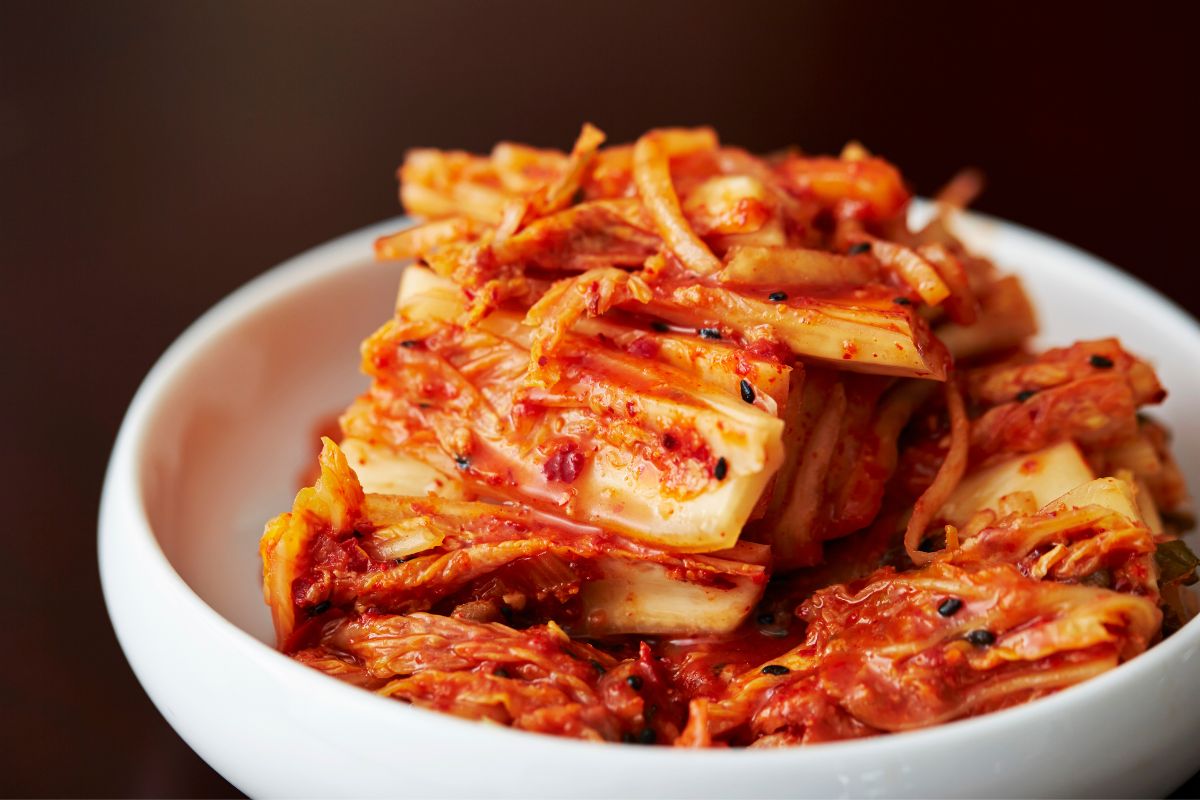Kimchi is one of the most famous dishes in Korean cuisine.
As one of the most popular and beloved side dishes in Korea, this fermented delicacy has a rich history dating back thousands of years. It’s known for its vibrant colors, beautiful aroma, and complex flavors.

If you’ve never tried kimchi before, however, you may not have any idea of what it tastes like.
Even if you have tried kimchi, you might struggle to find the right words to describe the depth of flavors found in kimchi.
In this article, we will take a closer look at kimchi and will describe what it tastes like. We’ll look at the ingredients and variations to see how this unique and delicious dish is made.
What Is Kimchi?
Let’s begin by explaining what kimchi is. It’s a traditional Korean dish that can be eaten as a side dish but is also commonly used as an ingredient in a wide variety of other Korean dishes as well.
There is no single recipe for kimchi. Different brands all make their own variations and families across Korea all have their own recipes as well.
However, there are certain characteristics that all versions of kimchi share.
Typically, kimchi includes vegetables, ginger, garlic, chili peppers, salt, and fish sauce.
The most common vegetable that is used is cabbage, but you will also find other vegetables such as radish, carrots, cucumber, and scallions.
The mix of ingredients is pickled and fermented to make the flavors mix and become stronger.
Once prepared, kimchi lasts for a long time, making it a great dish to prepare in bulk in advance and keep prepared for whenever it is needed.
The Taste Of Kimchi
As the ingredients used in kimchi can vary greatly, it also means that the taste of kimchi itself can vary greatly as well.
Due to the way it is prepared, however, you can expect a few similar notes to be present in almost every type of kimchi, regardless of whether it is homemade or store-bought.
Kimchi has several strong flavors and is often described as being simultaneously sour, spicy, and umami. The strongest of these is typically the sour flavors as kimchi is fermented.
During the fermentation process, lactic acid is produced by bacteria and this gives kimchi a very tangy flavor. If there is any garlic included in the kimchi, the fermentation process will greatly intensify the notes of garlic.
The next flavor that stands out the most is spice.
Kimchi is usually made with pepper and is known for being a spicy dish, although the level of spice can vary greatly depending on who has made it. Some kimchi may only be mildly spicy whereas others can be dangerously so!
The umami flavors in kimchi are produced by the inclusion of fish-related ingredients. Fish paste or fish sauce are the most common, but it’s not unusual for anchovies to be included either.
If the kimchi is vegan or doesn’t have anything fishy in it, the umami flavors are either lessened or completely eliminated.
This is especially true of kimchi made with a higher concentration of radishes or cucumbers.
Is Kimchi Like Sauerkraut?

You might occasionally see kimchi compared to the German dish sauerkraut. The two dishes do share some similarities as they are both fermented foods that are made from cabbage.
During its fermentation process, sauerkraut also produces lactic acid and this gives it a sour taste that is similar to the sour taste of kimchi.
However, the two are also very different. Although both use cabbage, sauerkraut is made with shredded cabbage heads, and kimchi is typically made with intact leaves and stems.
They both have different ingredients added to them as well. Sauerkraut usually includes dill and caraway seeds but neither of these are present in kimchi.
Kimchi is much spicier and saltier than sauerkraut and has a higher level of antioxidants.
As well as the shared sour taste, the two have different flavor profiles. Sauerkraut has more of a flowery scent and taste because of the yeast growth whereas kimchi is spicy and less acidic.
How To Store Kimchi
We mentioned earlier that kimchi has a pretty long shelf life and this is due to the fermentation process. When kept in the fridge, kimchi will remain fresh and delicious for several months.
Even past that date, kimchi is still safe to eat. All that will happen is that the flavors will continue to develop so the aroma and taste of the kimchi will become stronger and more pungent.
This won’t be dangerous but might make it difficult to eat! You may also find that some of the crunchy vegetables in the kimchi will become softer than they should be.
Popular Recipes That Use Kimchi
Kimchi is delicious as a side dish and is commonly eaten on its own as part of a bigger meal.
However, it can also be used to add some extra flavor and spice to a large number of Korean dishes.
Kimchi Dumplings (Kimchi Mandu)
Dumplings are very popular in Korea and one of the most common fillings involves kimchi.
Mix in some kimchi with pork, beef, or tofu and you will have delicious dumplings! They can be steamed or fried and served with a dipping sauce.
Kimchi Fried Rice (Kimchi Bokkeumbap)
Add some kimchi to your fried rice to make it more flavorsome! It can be served with a mix of other ingredients as well such as green onions, bacon, or eggs.
Kimchi Stew (Kimchi Jjigae)
Stew is a comfort food around the world and Korea is no different. Add some kimchi and pork to get a warming and filling dish.
Final Thoughts
In this article, we introduced kimchi and what it tastes like. We explained how it can be made and also listed a few popular Korean recipes that include kimchi.
- How To Reheat A Cheesesteak - November 5, 2023
- What Are Three Must Have Kitchen Knives? - September 22, 2023
- How To Protect Edges Of Pie Crust - June 15, 2023








